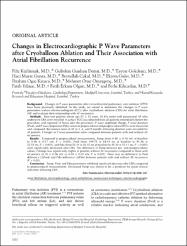Changes in electrocardiographic p wave parameters after cryoballoon ablation and their association with atrial fibrillation recurrence

Göster/
Erişim
info:eu-repo/semantics/openAccessTarih
2016Yazar
Kızılırmak, FilizGünhan Demir, Gültekin
Gökdeniz, Tayyar
Güneş, Hacı Murat
Çakal, Beytullah
Güler, Ekrem
Karaca, İbrahim Oğuz
Omaygenç, Mehmet Onur
Yılmaz, Fatih
Olgun, Fatih Erkam
Kılıçaslan, Fethi
Üst veri
Tüm öğe kaydını gösterKünye
Kızılırmak, F., Günhan Demir, G., Gökdeniz, T., Güneş, H. M., Çakal, B., Güler, E. ... Kılıçaslan, F. (2016). Changes in electrocardiographic p wave parameters after cryoballoon ablation and their association with atrial fibrillation recurrence. Annals of Noninvasive Electrocardiology, 21(6), 580-587. https://dx.doi.org/10.1111/anec.12364Özet
Background: Changes in P wave parameters after circumferential pulmonary vein isolation (CPVI) have been previously identified. In this study, we aimed to determine the changes in P wave parameters surface electrocardiogram (ECG) after cryoballoon ablation (CBA) for atrial fibrillation (AF) and evaluate their relationship with AF recurrence. Methods: Sixty-one patients (mean age 53 ± 11 years, 50.8% male) with paroxysmal AF who underwent CBA were enrolled. A surface ECG was obtained from all patients immediately before the procedure, and repeated 12 hours after the procedure. P wave amplitude (Pamp), P wave duration (Pwd), and P wave dispersion (Pdis) values in preprocedural and postprocedural ECGs were measured and compared. Recurrence rates of AF in 3, 6, and 9 months following ablation were recorded for all patients. Changes in P wave parameters were compared between patients with and without AF recurrence. Results: Compared to preprocedural measurements, Pamp (from 0.58 ± 0.18 mV at baseline to 0.48 ± 0.17 mV, P < 0.001), Pwd (from 109.72 ± 18.43 ms at baseline to 91.36 ± 22.53 ms, P < 0.001), and Pdis (from 55.44 ± 20.45 ms at baseline to 45.30 ± 15.31 ms, P < 0.001) were significantly decreased after CBA. The difference in Pamp between pre- and postprocedural values (?Pamp) was significantly higher in patients without AF recurrence compared to those with recurrence (0.10 ± 0.06 mV vs 0.04 ± 0.01 mV, P = 0.002). There was no difference in Pwd difference (?Pwd) and Pdis difference (?Pdis) between patients with and without AF recurrence (P > 0.05). Conclusion: Pamp, Pwd, and Pdis parameters exhibited significant decrease after CBA compared to preprocedural measurements. Decreased Pamp was shown to be a predictor for good clinical outcomes following CBA.
WoS Q Kategorisi
Q4Scopus Q Kategorisi
Q2Kaynak
Annals of Noninvasive ElectrocardiologyCilt
21Sayı
6Koleksiyonlar
- Makale Koleksiyonu [3736]
- PubMed İndeksli Yayınlar Koleksiyonu [4177]
- Scopus İndeksli Yayınlar Koleksiyonu [6494]
- WoS İndeksli Yayınlar Koleksiyonu [6562]

















